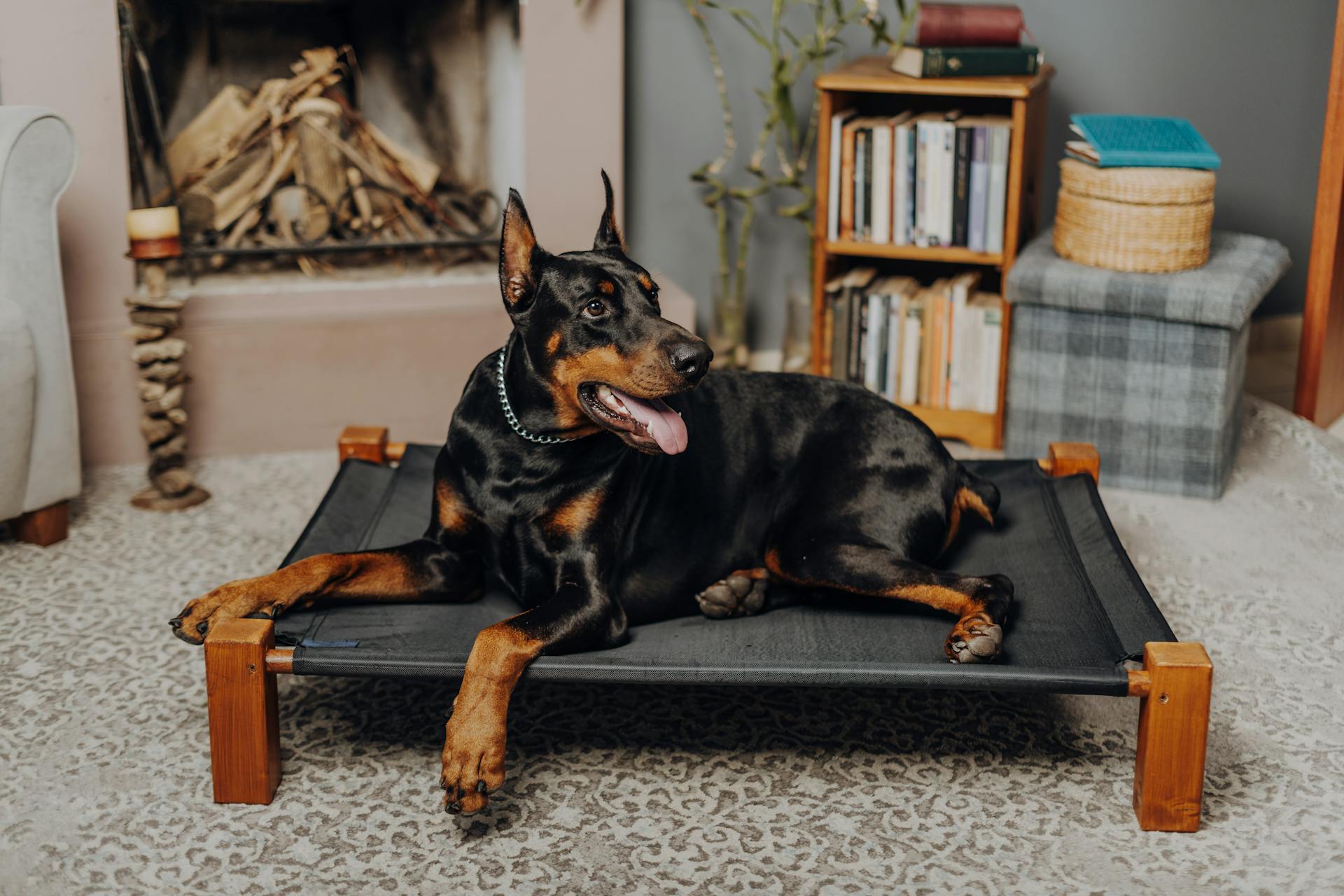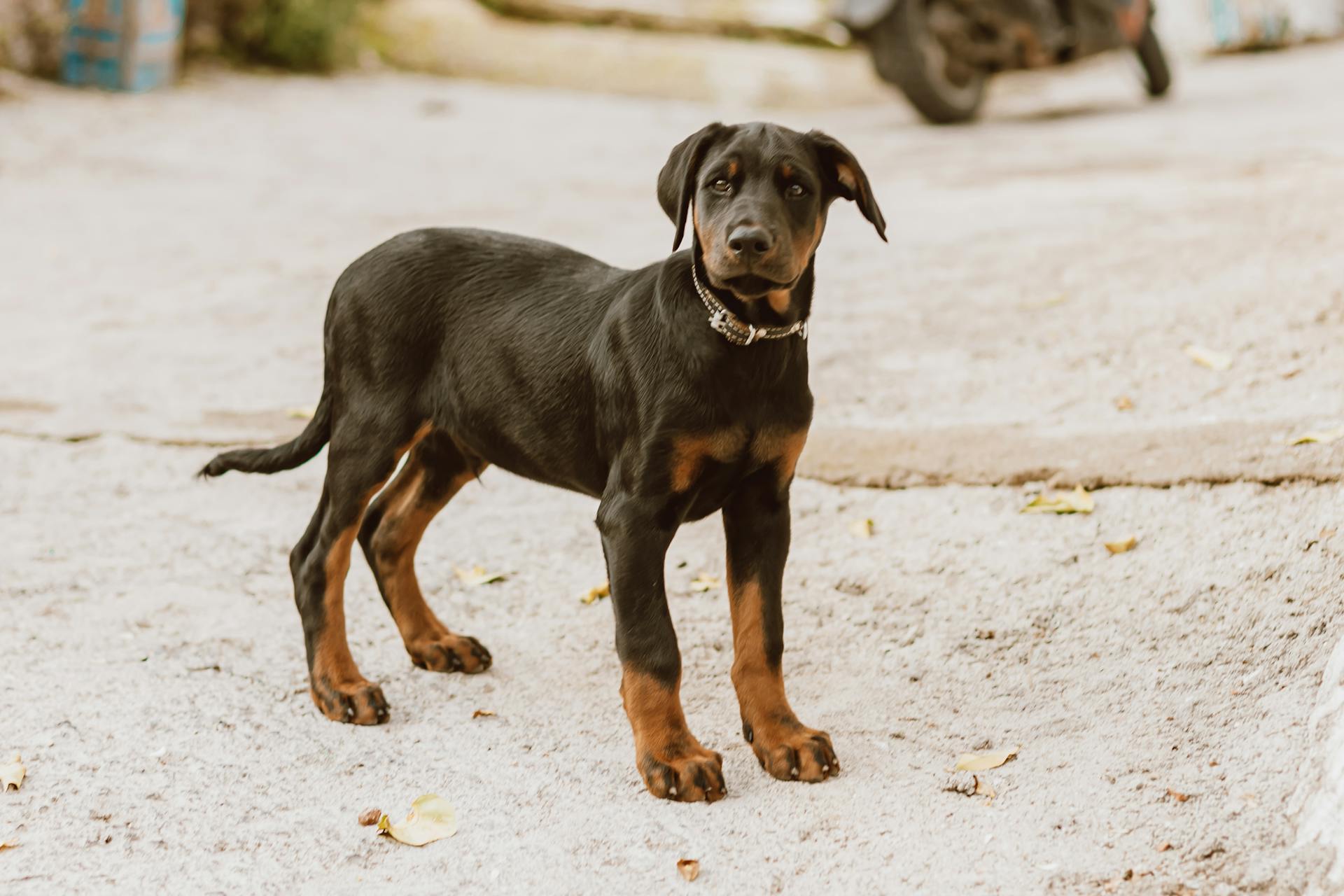
Pitbulls are often stereotyped as aggressive dogs, but this isn't entirely accurate. In reality, Pitbulls are loyal and loving companions that thrive on human interaction.
One of the key reasons Pitbulls get a bad rap is their history as fighting dogs. Unfortunately, this past has led to a misconception about their temperament. They were originally bred for their strength and agility, not for aggression.
Doberman Pinschers, on the other hand, are often seen as intimidating due to their sleek appearance and powerful build. However, they're also known for being intelligent and gentle with their families.
Readers also liked: Temperament of Doberman Pinschers
Physical Traits
The Doberman and Pitbull are two distinct breeds with notable physical differences. The Doberman is significantly larger, measuring between 24 and 28 inches tall and weighing between 60 and 100 pounds.
A key difference in their appearance is their ear shape, with the Doberman sporting large, drop triangle-shaped ears and the Pitbull sporting rose-shaped ears. Both breeds often have their ears cropped to fit their traditional looks.
Both Dobermans and Pitbulls have a shiny coat, but the Doberman's coat is slightly longer. The Doberman typically sports a black and rust color with distinctive markings, while the Pitbull Terrier is accepted in almost all dog colors, but more popular in red and blue.
Size and Weight
Dobermans are typically larger than Pit bulls, with males growing up to 28 inches in height and weighing between 75 and 100 pounds.
Pit bulls, on the other hand, are stockier and have a more muscular build, with males measuring between 17 and 20 inches in height and weighing between 30 and 65 pounds.
A Doberman would typically need around four cups of kibble per day, while a Pit bull would require two and a half cups of food.
Both breeds are generally large, active dogs and need a substantial amount of living space to run and burn off excess energy.
The Doberman Pinscher seems to do better living indoors, but either breed would thrive most on a high-protein diet.
Coat Type and Grooming
Both Doberman and Pitbull have short, smooth coats that require regular grooming. The Doberman's coat, typically seen in black and rust coloration, needs to be brushed twice a week, while the Pitbull requires brushing only once a week.
A different take: Pitbull Dog Pregnancy Week by Week Images
Pitbulls shed less than Dobermans, making them a low-maintenance option for those who prefer a cleaner home environment. Seasonal shedding is a common issue for both breeds, and regular bathing and nail clipping are necessary.
The Doberman sheds more than the Pitbull, so they need more frequent brushing to keep their coat dander-free and healthy. Regular ear cleaning is also important for Dobermans, especially if their natural ear shape is not altered.
Both breeds are relatively short-coated, but they still require regular grooming to stay healthy and clean.
A fresh viewpoint: Pitbull Dog Ear Cut
Appearance
The Doberman Pinscher and the Pitbull Terrier are two breeds that couldn't look more different, despite their athletic build.
The Doberman is significantly larger, measuring between 24 and 28 inches tall, and weighing between 60 and 100 pounds.
Their coats are similar in that they're shiny, but the Doberman's coat is slightly longer.
The Doberman typically sports a distinctive black and rust color, while the Pitbull Terrier comes in almost all colors, but is more commonly seen in red and blue.
On a similar theme: Pug vs Boston Terrier
The Pitbull Terrier is not accepted in the merle color, and the Doberman is not accepted with a white coat, as this is considered albinism or leucism.
Their ears are another notable difference, with the Doberman sporting large, drop-shaped ears, and the Pitbull sporting rose-shaped ears.
It's worth noting that both breeds often have their ears cropped to fit their traditional looks.
Temperament and Behavior
Both Dobermans and Pitbulls are intelligent breeds, with Dobermans known for their high level of intelligence and Pitbulls being intelligent and trainable, although possibly more stubborn.
They are both loyal and loving with their families, and will do anything to please them.
Dobermans are naturally protective and alert, making them excellent guard dogs, while Pitbulls are fearless and energetic, with a strong devotion to their families.
However, both breeds can suffer from separation anxiety, which can lead to unwanted behaviors like excessive barking and chewing.
Socialization is key to raising a confident and calm dog, and both breeds require early training and exposure to new faces, people, and animals.
Pitbulls, in particular, can be aggressive if not properly trained and socialized, due to their background as a fighter.
Dobermans, on the other hand, can be strong-willed and dominant, requiring experienced owners or those willing to take on the challenge.
Despite their differences, both breeds can make excellent companions with the right training and care.
They are both playful and puppy-like long into their mature years, making them a great addition to families with older children.
With patience, consistency, and positive reinforcement, both breeds can become well-trained and obedient pets.
Health and Care
Doberman and Pitbull dogs are both generally hardy breeds, but they can be prone to certain health conditions as they age. The Doberman can live between 10 and 12 years.
Some of the health issues that can afflict the Doberman include thyroid disease, heart issues, hip dysplasia, and Von Willebrand disease, which is a blood clotting disorder. Regular cardiac screenings and early detection are important for managing conditions like dilated cardiomyopathy (DCM), a condition that affects the heart muscle.
A different take: American Pit Bull Terrier Health Issues
Pitbulls can live to be up to 14 years old. They have been known to suffer from hip and elbow dysplasia, thyroid disease, and degenerative myelopathy, an untreatable spinal cord disease.
Both breeds need a high-quality, protein-packed, grain-free kibble. On average, you should feed a Doberman around four cups of kibble every day, while a Pitbull requires two and a half cups of food.
Doberman and Pitbull dogs are both low shedders with simple grooming needs, thanks to their short, fine coats. Brushing them once or twice per week is enough, and you should also clip their nails and clean their ears as needed.
Training and Exercise
Both Pitbulls and Dobermans are highly trainable breeds that thrive on structure and positive reinforcement. They require a strong leader who is consistent and fair, and positive reinforcement works best when potty training them and teaching them basic commands.
Pitbulls and Dobermans need at least an hour of exercise daily, and they adore jogging, hiking, and romping around the backyard. Engage them in activities that involve running and chasing, and aim for 60 to 90 minutes of intense exercise each day.
Both breeds benefit from agility courses and games like catch, fetch, and tug of war, which engage their muscles and minds. Long-lasting bones, chew toys, and other toys will keep them entertained and occupied during downtime, preventing destructive behaviors that can arise from too much cooping up.
Recommended read: Pitbull Proof Dog Toys
Exercise

Exercise is a must for these energetic breeds. They require at least an hour of exercise daily, with both Pitbulls and Dobermans loving jogging, hiking, and backyard romps.
Both breeds need plenty of physical activity every day, and engaging in activities like long walks, jogging, or interactive play sessions can help. These activities should last around 60 to 90 minutes, with a focus on intense exercise to keep them healthy and content.
Pitbulls benefit from agility courses that engage both their muscles and mind, while Dobermans enjoy games like catch, fetch, and tug of war. They also love long-lasting bones, chew toys, and other toys to keep them occupied during downtime.
Spending too much time in freezing temperatures is not recommended for Dobermans due to their short fur. It's essential to consider their coat when planning outdoor activities.
Both breeds can resort to destructive behaviors if cooped up for too long, so it's crucial to provide them with enough exercise and mental stimulation.
A unique perspective: How Long Is a Pitbull Dog Pregnant
Training

Training your Dober Pit requires time, patience, love, and energy. You need to be patient, calm, and consistent, as they can be stubborn and dominant.
Positive reinforcement techniques are the best way to train them in obedience and socialization. Guiding them with a firm but gentle hand is the key to success.
Dober Pits are very loyal and protective, and they want to please you. They will need to overcome their independence and stubbornness, but it's well worth it.
Dobermans are known for their high level of intelligence, which allows them to quickly learn commands. They are also known for their loyalty and enthusiasm to please their owners.
Pit bulls are intelligent and trainable, but may be more stubborn than Dobermans, making training more challenging. However, with patience, consistency, and positive reinforcement, they can also become well-trained and obedient pets.
Pit bulls are muscular and energetic dogs that require intense exercise to stay healthy and content. Aim for 60 to 90 minutes of intense exercise each day.
Readers also liked: Pitbull Dog Training

Positive reinforcement training is really important to train both Dobermans and Pit bulls, and it's likely that they will both be driven by praise from their master. The odd treat would also be appreciated, especially for Pit bulls.
Socialization is crucial from an early age to get them used to being around different animals and humans of all ages and sizes. This will help prevent overprotectiveness in Dobermans.
The Doberman will need much more intense training than the Pit bull to ensure obedience and prevent challenging the pack hierarchy. Enrolling him in an obedience training class will help him become a well-balanced and polite pooch.
Pit Bulls are loyal dogs but not necessarily friendly to others. You must go to extra lengths to make sure they understand your leadership, which requires a strong leader who is consistent and fair.
Choosing a Pet
Both Dobermans and Pit bulls can be excellent choices for active families seeking a loyal guardian and effective guard dogs.
Consistency is key for both breeds, requiring consistent exercise routines to keep them happy and healthy.
Choosing the Right Breed
Choosing a pet is a big decision, and it's essential to consider your lifestyle and the specific needs of each breed to ensure a compatible match for your family.
Active families who want a loyal guardian might consider breeds known for their potential as effective guard dogs.
Both Doberman and Pit bull breeds can be excellent choices for active families, but there are certain considerations to keep in mind.
You'll want to evaluate the needs of each breed to ensure they fit with your family's schedule and living situation.
Both breeds require regular exercise and mental stimulation, so you'll need to consider how you can provide for their physical and emotional needs.
For your interest: Pitbull Dog Good Family Dog
Co-Habitation Options
If you're considering getting a Doberman or a Pit bull, you need to evaluate your lifestyle and the specific needs of each breed to ensure a compatible match for your family.
Both breeds can be excellent choices for active families seeking a loyal guardian and are known for their potential as effective guard dogs.

You'll need to assess individual temperaments and carefully manage introductions if you have other pets in the home, as some Dobermans and Pitbulls can coexist peacefully with other pets, while others may have a higher prey drive or be less tolerant.
Both Dobermans and Pit Bulls are strong-minded, tenacious breeds that need consistent, firm training from an early age. With proper socialization and a responsible owner, there is no reason why these dogs should not get along well in the same home.
However, it's essential to remember that both breeds are powerful and can be dangerous if not properly trained and socialized.
Frequently Asked Questions
Is a Doberman powerful than a Pitbull?
Both Doberman Pinschers and Pitbulls are powerful breeds, but their strength is comparable rather than one being significantly more powerful than the other. Proper training and socialization are key to unlocking their full potential as loyal and intelligent family pets and guard dogs.
Can any dog defeat Pitbull?
Yes, certain breeds of dogs, such as larger and more powerful breeds like Rottweilers and Doberman Pinschers, can potentially defeat a Pitbull in a fight. However, the outcome depends on various factors, including the individual dog's size, strength, and temperament.
Featured Images: pexels.com


